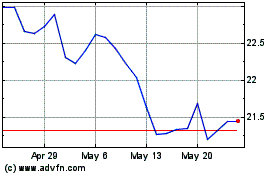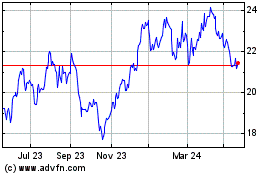2nd UPDATE: BlueScope Steel Loss Deepens As Materials Costs Rise
February 21 2011 - 12:35AM
Dow Jones News
Australia's resources boom is killing off other sectors of the
country's economy, the chief executive the country's largest
steelmaker by revenue warned Monday, as BlueScope Steel Ltd.
(BSL.AU) reported a deepening of losses during its fiscal first
half to Dec. 31.
Booming prices for steelmaking raw materials are cutting profit
margins for steelmakers worldwide despite delivering record profits
for miners, while the commodity-driven strength of the Australian
dollar is putting pressure on the domestic manufacturing sector and
cutting demand for steel products, Paul O'Malley said.
"It's a tough time to be a manufacturer in Australia, in fact a
very tough time," he said. "This economy needs to be more than just
a one-trick pony."
Diversified miners including Australia's BHP Billiton Ltd.
(BHP), Rio Tinto Ltd. (RIO), and Fortescue Metals Group Ltd.
(FMG.AU) have announced surging profits over the past two weeks on
the back of near-record prices for steelmaking materials,
particularly iron ore and coking coal. European counterparts Anglo
American PLC (AAL.LN) and Xstrata PLC (XTA.LN), which have
significant operations in the country, have declared similarly
impressive results.
But business leaders and economic policymakers, including
Reserve Bank of Australia Governor Glenn Stevens and RBA board
member Roger Corbett, have warned in recent months that Australia's
mining boom is hollowing out other parts of the economy.
BlueScope said net losses in its fiscal first half ended Dec. 31
nearly doubled to A$55 million from A$28 million the previous year,
despite revenues rising 13% to A$4.62 billion from A$4.11
billion.
The outcome also illustrates the stark divide between miners and
producers in the steel industry, as iron ore and coking coal costs
rise against a more restrained backdrop for steel prices. Steel is
a crucial commodity for the world's manufacturing and construction
sectors and a vital indicator of global economic health.
Each ton of steel requires around 1.5 tons of iron ore and 0.6
ton of coking coal. O'Malley said that the cost of raw materials,
which BlueScope largely buys from its former parent company BHP,
had risen to A$2.5 billion this year from A$400 million when it was
spun out of BHP in 2002.
East Asian hot-rolled coil, a benchmark sheet metal product, has
risen 18% to US$730 a metric ton from US$620 since the new year
amid rising expectations of global growth, according to
Commonwealth Bank of Australia. But record wet weather in mining
regions of Australia has driven up prices of iron ore and coking
coal still further.
BlueScope said the A$285 million deterioration in its underlying
earnings from the second half of the 2010 financial year was
largely caused by a A$356 million increase in materials costs,
which was offset by only a A$106 million improvement in steel sale
prices.
BlueScope's results were also hit by a stronger Australian
dollar cutting into export margins and offshore profits, by lower
steel demand in Australia, and A$16 million of negative accounting
and tax changes, the company said.
O'Malley also said profits would improve by A$200 million if the
local currency fell back to the US$0.8000 level it hovered below
for most of the past two decades. It last traded at US$1.0115.
The strong dollar is trimming the value of BlueScope's offshore
profits in local currency terms, O'Malley said, while upward
pressure on the cost of Australian exports was cutting steel demand
from the country's beleaguered manufacturing sector.
"Demand in Australia is 20% off where it was six months ago," he
said.
Australia's construction and manufacturing sectors have been hit
hard in recent months by a stronger currency and rising interest
rates caused by the resurgent mining sector. Output in the two
sectors has been in decline since August and May, respectively,
according to the Australian Industry Group, a trade body.
On an underlying basis excluding one-off items, the company's
net loss narrowed 11% to A$47 million from A$53 million. Management
predicted that the company would break even in the second half of
the year and proposed an interim dividend of 2 cents per share,
including franking tax credits, compared to a halted payout the
year before.
-By David Fickling, Dow Jones Newswires; +61 2 8272 4689;
david.fickling@dowjones.com
Bluescope Steel (ASX:BSL)
Historical Stock Chart
From Apr 2024 to May 2024

Bluescope Steel (ASX:BSL)
Historical Stock Chart
From May 2023 to May 2024
